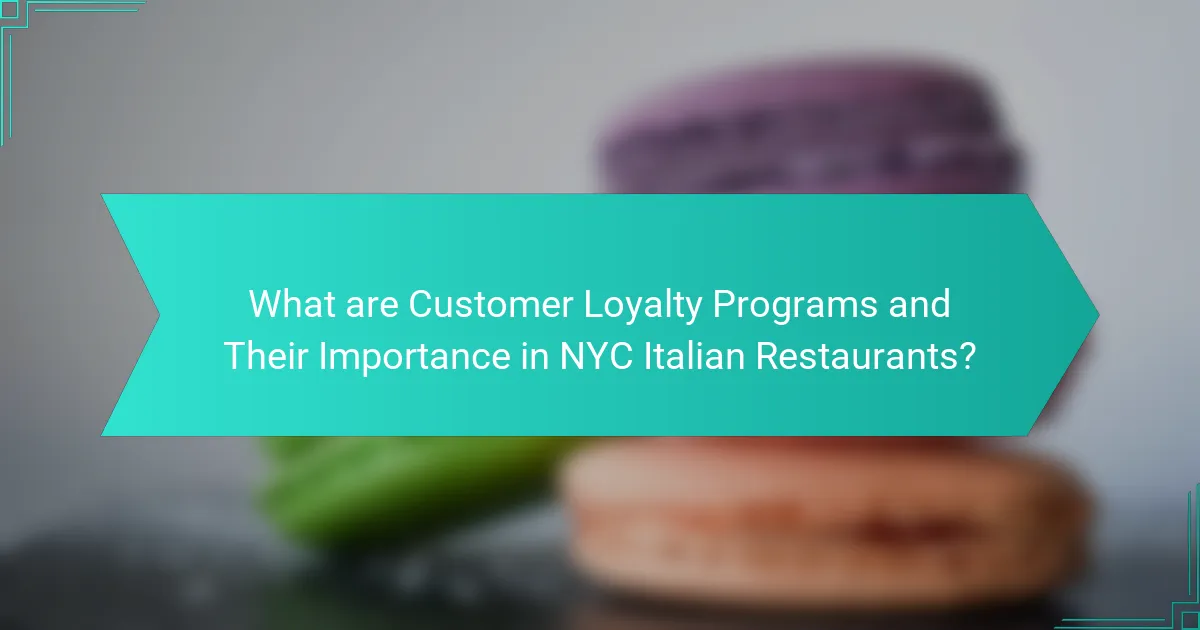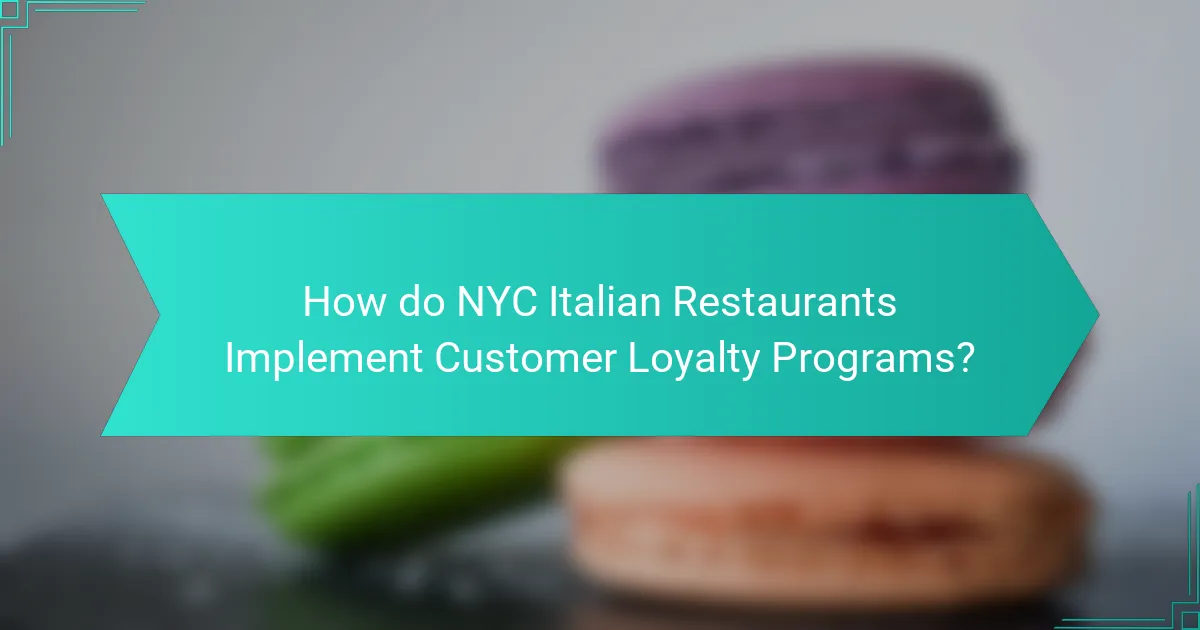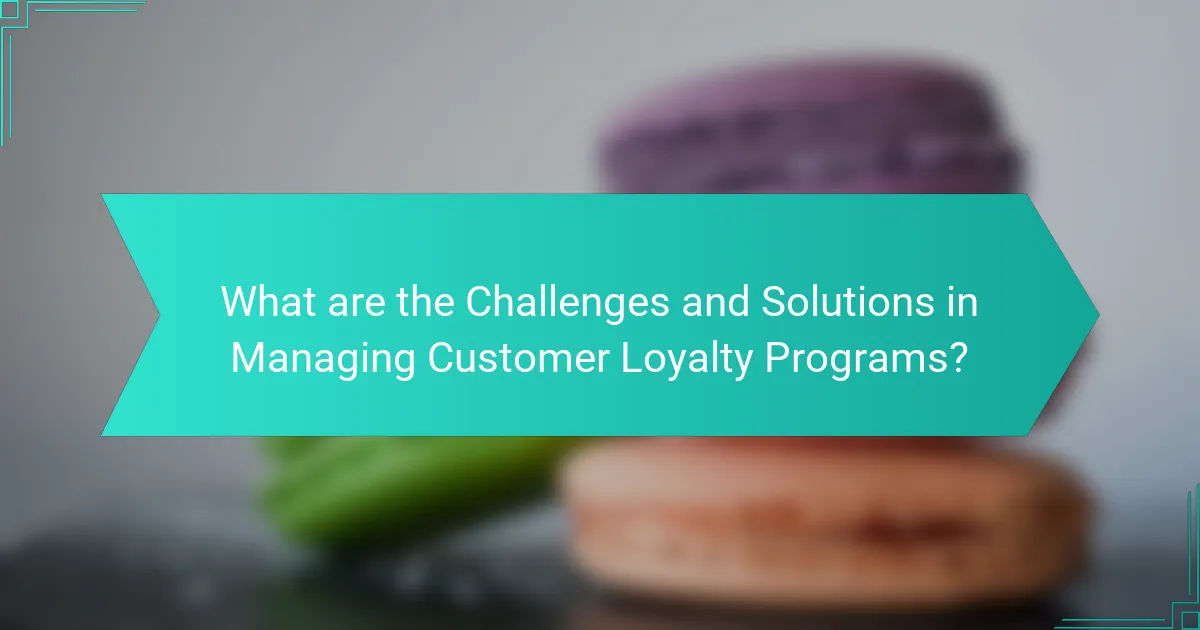Customer loyalty programs are structured marketing strategies aimed at encouraging repeat business in NYC Italian restaurants. These programs reward customers with discounts, exclusive offers, and personalized promotions, leading to increased customer retention and enhanced dining experiences. Research indicates that a significant percentage of consumers engage with loyalty programs, which can boost visit frequency and spending. However, challenges such as low engagement rates and complex program designs can hinder their effectiveness. Solutions like simplifying program structures and leveraging customer data can improve participation and service quality in these establishments.

What are Customer Loyalty Programs and Their Importance in NYC Italian Restaurants?
Customer loyalty programs are structured marketing strategies designed to encourage repeat business. In NYC Italian restaurants, these programs reward customers for their loyalty, often through discounts or exclusive offers. They help build a strong customer base by enhancing the dining experience. Loyalty programs can increase customer retention rates. According to a study by Accenture, 77% of consumers participate in loyalty programs. This high engagement leads to increased frequency of visits and higher spending per visit. Additionally, these programs can provide valuable data on customer preferences. This information allows restaurants to tailor their offerings and improve service quality.
How do Customer Loyalty Programs function in enhancing customer retention?
Customer loyalty programs enhance customer retention by incentivizing repeat purchases. These programs often offer rewards, discounts, or exclusive benefits for loyal customers. They create a sense of belonging and appreciation among customers. This emotional connection encourages customers to choose the brand over competitors. According to a study by Accenture, 66% of consumers are more likely to choose a brand with a loyalty program. Additionally, loyalty programs can lead to increased customer spending. Research shows that loyal customers can spend up to 67% more than new customers. Overall, customer loyalty programs effectively foster long-term relationships with consumers, driving retention.
What specific features are common in effective Customer Loyalty Programs?
Effective Customer Loyalty Programs commonly feature rewards systems, personalized offers, and tiered membership levels. Rewards systems incentivize repeat purchases through points or discounts. Personalized offers enhance customer engagement by tailoring promotions to individual preferences. Tiered membership levels encourage customers to increase their spending to unlock greater benefits. These features create a sense of value and belonging among customers. Research indicates that programs with these elements see higher retention rates and customer satisfaction. For instance, a study by the Harvard Business Review found that effective loyalty programs can increase customer retention by 5% to 10%.
How do these features contribute to customer satisfaction in NYC Italian restaurants?
Customer satisfaction in NYC Italian restaurants is enhanced by features such as personalized service, quality ingredients, and loyalty programs. Personalized service makes customers feel valued, leading to repeat visits. Quality ingredients ensure that dishes meet high culinary standards, which is essential for positive dining experiences. Loyalty programs reward frequent customers, fostering a sense of community and encouraging ongoing patronage. According to a study by the National Restaurant Association, 70% of consumers are more likely to return to a restaurant that offers loyalty rewards. These features collectively create a welcoming atmosphere, ensuring customers leave satisfied and eager to return.
Why are Customer Loyalty Programs critical for service quality improvement?
Customer loyalty programs are critical for service quality improvement because they incentivize repeat business and foster customer engagement. These programs encourage customers to return, which allows businesses to gather valuable feedback on service quality. Regular interactions with loyal customers provide insights into their preferences and expectations. This information can be used to tailor services to meet specific needs. Studies show that businesses with loyalty programs see a 5-10% increase in customer retention rates. Higher retention rates correlate with improved service quality, as businesses strive to meet the expectations of their loyal clientele. Additionally, satisfied loyal customers often share positive experiences, enhancing the restaurant’s reputation and attracting new customers.
What role does customer feedback play in shaping service quality through loyalty programs?
Customer feedback is crucial in shaping service quality through loyalty programs. It provides insights into customer preferences and expectations. This feedback allows restaurants to tailor their services effectively. For instance, a survey may reveal that customers prefer faster service during peak hours. Restaurants can then adjust staffing or processes accordingly. Additionally, positive feedback can reinforce successful practices. Negative feedback highlights areas needing improvement. According to a study by the Journal of Service Research, businesses that actively seek and implement customer feedback improve service quality by 30%. This demonstrates the significant impact of customer feedback on enhancing service quality through loyalty programs.
How can loyalty programs incentivize staff to enhance service quality?
Loyalty programs can incentivize staff to enhance service quality by offering rewards tied to customer satisfaction metrics. These programs create a direct link between employee performance and tangible benefits. For example, staff may receive bonuses or recognition for positive customer feedback. This motivates employees to provide better service to earn rewards. Research shows that incentivized staff are more likely to engage positively with customers. A study by the Harvard Business Review found that companies with employee reward programs see a 20% increase in customer satisfaction. Therefore, loyalty programs can effectively drive staff to improve service quality through structured incentives.

How do NYC Italian Restaurants Implement Customer Loyalty Programs?
NYC Italian restaurants implement customer loyalty programs through various strategies. They often utilize point-based systems where customers earn points for each purchase. These points can later be redeemed for discounts or free items. Many restaurants also offer exclusive member-only promotions and events. Some establishments send personalized offers via email or mobile apps to encourage repeat visits. Additionally, loyalty programs may include tiered memberships, rewarding frequent diners with increasing benefits. Research shows that 70% of customers are more likely to recommend restaurants with loyalty programs. This approach enhances customer retention and service quality.
What types of Customer Loyalty Programs are popular among NYC Italian Restaurants?
Reward points systems are popular among NYC Italian restaurants. Customers earn points for each purchase. These points can be redeemed for discounts or free items. Another common type is tiered loyalty programs. Customers achieve different status levels based on their spending. Higher tiers offer exclusive benefits, such as special menu items or priority reservations. Punch cards are also frequently used. Customers receive a stamp for each visit, leading to a free meal after a set number of visits. Referral programs encourage customers to bring friends. Customers receive rewards for each new diner they introduce. These programs enhance customer retention and satisfaction, contributing to improved service quality.
How do these programs differ in structure and benefits?
Customer loyalty programs at NYC Italian restaurants differ in structure and benefits. Some programs use point-based systems, while others offer tiered memberships. Point-based systems reward customers for every dollar spent, allowing them to accumulate points for discounts or free items. Tiered memberships, on the other hand, provide escalating benefits based on customer spending levels.
The benefits also vary significantly. Point-based programs often focus on immediate rewards, enhancing customer satisfaction quickly. Tiered programs tend to foster long-term loyalty through exclusive perks, such as personalized services or special event invitations. Research shows that 70% of customers prefer loyalty programs that offer instant rewards, while 60% appreciate tiered benefits for sustained engagement.
These structural and benefit differences influence customer retention and overall satisfaction in NYC Italian restaurants.
What are the most effective strategies for promoting these programs?
Effective strategies for promoting customer loyalty programs include leveraging social media, email marketing, and in-store promotions. Social media platforms can reach a wide audience quickly. Engaging content can attract potential customers and inform them about loyalty benefits. Email marketing allows for personalized communication. Sending targeted offers can encourage sign-ups and participation. In-store promotions create immediate awareness. Displaying signage about the loyalty program can capture customers’ attention while they dine. Collaborating with local influencers can enhance visibility. Influencers can share their experiences, attracting their followers to the restaurant. Additionally, offering exclusive rewards can incentivize customers to join. Research shows that loyalty programs can increase repeat visits by up to 30%. These strategies effectively enhance awareness and participation in loyalty programs.
How do restaurants measure the success of their Customer Loyalty Programs?
Restaurants measure the success of their Customer Loyalty Programs through various metrics. Common metrics include customer retention rates, which indicate how many customers return after joining the program. Additionally, restaurants track the frequency of visits by loyalty program members compared to non-members.
Average transaction value is another important measure. Restaurants analyze whether loyalty members spend more per visit. Customer feedback and satisfaction surveys also provide insights into program effectiveness.
Data analytics tools help in assessing overall program engagement. These tools can reveal trends and patterns in customer behavior. Finally, the growth of the customer base can indicate the program’s appeal.
Research shows that effective loyalty programs can increase customer retention by up to 30%. This statistic underscores the importance of measuring program success accurately.
What key performance indicators (KPIs) are used to evaluate program effectiveness?
Key performance indicators (KPIs) used to evaluate program effectiveness include customer retention rate, customer satisfaction score, and average transaction value. Customer retention rate measures the percentage of repeat customers over a specific period. Customer satisfaction score assesses how well the program meets customer expectations. Average transaction value indicates the revenue generated per customer visit. These KPIs provide insights into the loyalty program’s success and its impact on service quality. Research shows that effective loyalty programs can increase customer retention by up to 20%, enhancing overall service quality.
How can feedback from loyalty program participants inform service enhancement?
Feedback from loyalty program participants can significantly inform service enhancement. This feedback provides direct insights into customer preferences and experiences. Analyzing this information helps identify areas needing improvement. For instance, customers may suggest menu changes or highlight service speed issues. Implementing these suggestions can enhance overall satisfaction. Research indicates that businesses incorporating customer feedback see a 10-15% increase in customer retention. This approach fosters a customer-centric culture, leading to better service delivery. Thus, feedback serves as a valuable tool for continuous service enhancement in NYC Italian restaurants.

What are the Challenges and Solutions in Managing Customer Loyalty Programs?
Managing customer loyalty programs faces several challenges. Common issues include low engagement rates and difficulty in measuring program effectiveness. Many customers may not see the value in participating. This leads to underutilization of the program. Another challenge is the complexity of program design. Programs that are too complicated can confuse customers. Additionally, maintaining updated customer data is often problematic. Inaccurate data can hinder targeted marketing efforts.
Solutions to these challenges exist. Simplifying the program design can enhance customer understanding and participation. Offering clear, tangible rewards can increase perceived value. Regularly analyzing program performance metrics helps identify areas for improvement. Engaging customers through personalized communication can also boost loyalty. Finally, investing in robust customer relationship management systems aids in maintaining accurate data. These strategies can effectively address the challenges of managing customer loyalty programs.
What common challenges do NYC Italian Restaurants face with loyalty programs?
NYC Italian restaurants face several common challenges with loyalty programs. One major challenge is attracting new customers while retaining existing ones. Many loyalty programs fail to provide sufficient incentives that resonate with customers. Additionally, the diverse customer base in NYC complicates program design. Restaurants often struggle to tailor rewards that appeal to various demographics.
Another challenge is managing the technology behind loyalty programs. Many restaurants lack the resources for sophisticated systems. This can lead to issues with tracking customer purchases and rewards accurately. Furthermore, competition in NYC is fierce. Restaurants must differentiate their loyalty offerings to stand out.
Finally, maintaining customer engagement is a continuous hurdle. Restaurants need to regularly update their programs to keep customers interested. Overall, these challenges can hinder the effectiveness of loyalty programs in enhancing service quality.
How can restaurants overcome issues related to customer engagement?
Restaurants can overcome issues related to customer engagement by implementing effective customer loyalty programs. These programs incentivize repeat visits and foster a sense of belonging among customers. Research shows that 70% of consumers are more likely to recommend a brand with a good loyalty program. Additionally, personalized communication through loyalty programs can enhance customer experience. Engaging customers through exclusive offers and rewards increases their emotional connection to the restaurant. Consistent feedback collection helps restaurants understand customer preferences better. Data-driven insights allow for tailored promotions that resonate with patrons. Overall, a well-structured loyalty program can significantly boost customer engagement.
What strategies can be employed to keep the loyalty program fresh and appealing?
To keep a loyalty program fresh and appealing, restaurants should regularly introduce new rewards. This can include limited-time offers or seasonal promotions that entice customers. Engaging customers through personalized communication enhances their experience. Tailored messages based on purchase history can increase participation. Incorporating gamification elements, like challenges or point multipliers, can boost excitement. Additionally, soliciting customer feedback helps refine the program. Implementing suggestions shows customers their opinions matter. Regularly updating the program’s design and user interface keeps it visually appealing. These strategies create a dynamic loyalty program that encourages ongoing customer engagement.
What best practices should NYC Italian Restaurants follow for successful loyalty programs?
NYC Italian restaurants should implement personalized rewards to enhance customer loyalty. Tailoring incentives to individual preferences increases engagement. Regular communication through emails or apps keeps customers informed about promotions. Offering exclusive deals or events for loyalty members fosters a sense of belonging. Easy sign-up processes encourage participation in loyalty programs. Tracking customer purchases helps in understanding preferences and improving offerings. Feedback mechanisms allow restaurants to adapt their programs based on customer needs. These practices have been shown to increase repeat visits and customer satisfaction in the restaurant industry.
How can restaurants effectively integrate technology into their loyalty programs?
Restaurants can effectively integrate technology into their loyalty programs by utilizing mobile apps and digital platforms. These tools allow customers to track their rewards and redeem points easily. Implementing contactless payments can enhance the customer experience and streamline transactions. Restaurants can also use data analytics to personalize offers based on customer preferences. This targeted approach increases engagement and satisfaction. Additionally, incorporating social media can foster community and encourage sharing of loyalty experiences. Research shows that 70% of consumers are more likely to engage with brands that offer personalized experiences. By leveraging technology, restaurants can improve service quality and customer loyalty.
What tips can enhance customer experience through loyalty initiatives?
Implementing personalized rewards can significantly enhance customer experience through loyalty initiatives. Personalization makes customers feel valued and understood. Offering tailored rewards based on purchase history increases engagement. For instance, a study by McKinsey found that personalized experiences can lead to a 10-15% increase in customer satisfaction. Additionally, simplifying the enrollment process encourages more customers to join loyalty programs. A seamless sign-up experience can increase participation rates. Regular communication through targeted promotions keeps customers informed and engaged. According to research from Accenture, 83% of consumers appreciate being recognized as individuals. Lastly, providing exclusive access to events or special menu items fosters a sense of community. This exclusivity can drive loyalty and repeat visits.
Customer loyalty programs are structured marketing strategies that incentivize repeat business in NYC Italian restaurants, enhancing customer retention and satisfaction. These programs often feature rewards systems, personalized offers, and tiered memberships, which contribute to a stronger emotional connection between customers and restaurants. By gathering valuable customer feedback, these loyalty initiatives can inform service improvements and drive higher spending per visit. The article will explore the importance of these programs, their common features, challenges faced by restaurants, and best practices for effective implementation.